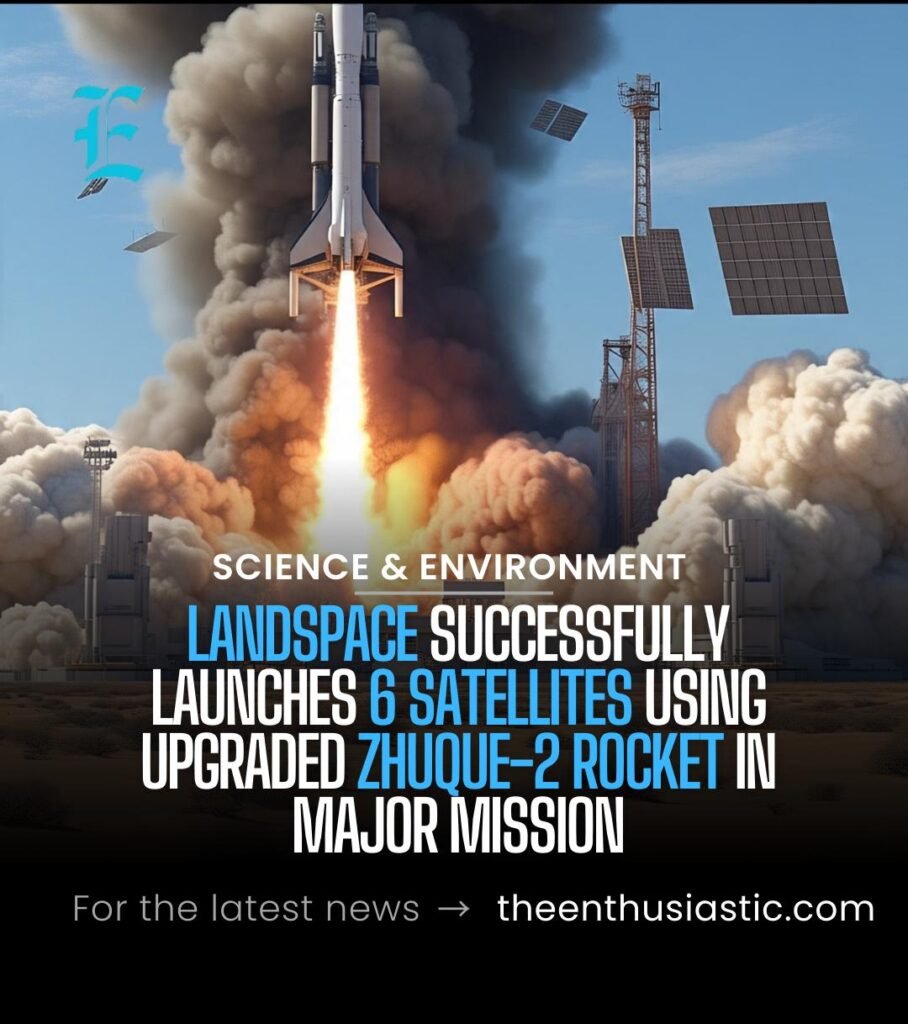Landspace Launches 6 Satellites Using Upgraded Zhuque-2E Rocket in Breakthrough Mission

Table of Contents
In a significant milestone for China’s commercial space industry, Landspace successfully launched six satellites into orbit early on May 17, utilizing its upgraded Zhuque-2E rocket. The launch took place at 12:12 a.m. Eastern (0412 UTC) from the Dongfeng Commercial Space Innovation Test Area at the Jiuquan Satellite Launch Center in northwest China.
This mission marked the fifth flight of a Zhuque-2 rocket and the second employing the enhanced Zhuque-2E variant. The rocket’s cargo consisted of six Tianyi satellites, developed by Chinese commercial satellite firm Spacety in partnership with several academic and commercial entities.
Satellites With Diverse Missions
The six satellites onboard serve a wide array of purposes:
Tianyi-42: Equipped for synthetic aperture radar (SAR) imaging
Tianyi-29 and Tianyi-35: Carry optical remote sensing instruments
Tianyi-34, Tianyi-45, and Tianyi-46: Dedicated to scientific experiments
Two of the satellites are part of the Tiansuan constellation, a project led by the Beijing University of Posts and Telecommunications. Notably, Tianyi-45 features argon ion thrusters for active deorbiting, reflecting a growing focus on space sustainability. Tianyi-34, on the other hand, is equipped with gamma-ray burst detectors, X-ray polarization sensors, and a camera designed to capture auroras—instruments that will contribute to both astrophysical research and Earth observation.
Technical Advancements in Zhuque-2E
This second flight of the Zhuque-2E introduced several technical upgrades:
Upgraded Tianque-12A engine for enhanced propulsion
New niobium-tungsten alloy nozzle for the second-stage Tianque-15A engine
Debut of quasi-real-time wind correction trajectory technology, which Landspace claims is a first in China
Standing at 47.3 meters tall, the Zhuque-2E rocket features an expanded 4.2-meter payload fairing, boosting its capacity to carry up to 4,000 kg to a 500-kilometer sun-synchronous orbit (SSO).
The rocket’s first flight in November 2024 successfully launched Guangchuan 01 and 02, which later completed a landmark 400 Gbps laser intersatellite link test, demonstrating high-speed space-based communication capabilities.
Zhuque-3 on the Horizon
While celebrating this successful launch, Landspace is also turning attention to its upcoming Zhuque-3 rocket, a stainless steel behemoth designed to deliver 21,000 kg to low Earth orbit. The two-stage vehicle will measure 76.6 meters in height and 4.5 meters in diameter, making it one of the largest commercial rockets in China.
Infrastructure for the Zhuque-3 was observed during the recent launch, signaling progress toward its debut. A static fire test is expected in June, following the successful integration test in April.
Part of China’s Busy 2025 Launch Schedule
This launch marks China’s 27th orbital mission of 2025, underscoring a period of accelerated launch activity in the country’s space sector. Recent missions include:
The classified TJS-19
Yaogan-40 (02) reconnaissance satellite
A set of 12 on-orbit computing satellites
At least four additional launches are expected within the month:
Ceres-1 sea launch (May 19)
Long March 7A (May 20)
Kinetica-1 (May 21)
The highly anticipated Tianwen-2 asteroid sample return mission (between May 28–30)
A Milestone for Commercial Space in China
Landspace’s successful Zhuque-2E mission further cements its position at the forefront of China’s burgeoning commercial space sector. With cutting-edge propulsion technologies, diversified satellite payloads, and larger rockets on the horizon, the company is playing a key role in expanding the nation’s access to space and contributing to global advancements in space science and technology.
